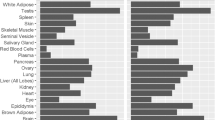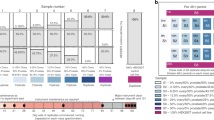Abstract
Multiple reaction monitoring (MRM) mass spectrometry has been successfully applied to monitor targeted proteins in biological specimens, raising the possibility that assays could be configured to measure all human proteins. We report the results of a pilot study designed to test the feasibility of a large-scale, international effort for MRM assay generation. We have configured, validated across three laboratories and made publicly available as a resource to the community 645 novel MRM assays representing 319 proteins expressed in human breast cancer. Assays were multiplexed in groups of >150 peptides and deployed to quantify endogenous analytes in a panel of breast cancer–related cell lines. The median assay precision was 5.4%, with high interlaboratory correlation (R2 > 0.96). Peptide measurements in breast cancer cell lines were able to discriminate among molecular subtypes and identify genome-driven changes in the cancer proteome. These results establish the feasibility of a large-scale effort to develop an MRM assay resource.
This is a preview of subscription content, access via your institution
Access options
Subscribe to this journal
Receive 12 print issues and online access
$259.00 per year
only $21.58 per issue
Buy this article
- Purchase on Springer Link
- Instant access to full article PDF
Prices may be subject to local taxes which are calculated during checkout





Similar content being viewed by others
References
Lange, V., Picotti, P., Domon, B. & Aebersold, R. Selected reaction monitoring for quantitative proteomics: a tutorial. Mol. Syst. Biol. 4, 222 (2008).
Picotti, P. & Aebersold, R. Selected reaction monitoring-based proteomics: workflows, potential, pitfalls and future directions. Nat. Methods 9, 555–566 (2012).
Pan, S. et al. Mass spectrometry based targeted protein quantification: methods and applications. J. Proteome Res. 8, 787–797 (2009).
Liebler, D.C. & Zimmerman, L.J. Targeted quantitation of proteins by mass spectrometry. Biochemistry 52, 3797–3806 (2013).
Hüttenhain, R. et al. Reproducible quantification of cancer-associated proteins in body fluids using targeted proteomics. Sci. Transl. Med. 4, 142ra94 (2012).
Rodriguez, H. et al. Reconstructing the pipeline by introducing multiplexed multiple reaction monitoring mass spectrometry for cancer biomarker verification: an NCI-CPTC initiative perspective. Proteomics Clin. Appl. 4, 904–914 (2010).
Addona, T.A. et al. Multi-site assessment of the precision and reproducibility of multiple reaction monitoring-based measurements of proteins in plasma. Nat. Biotechnol. 27, 633–641 (2009).
Anderson, N.L. et al. A human proteome detection and quantitation project. Mol. Cell. Proteomics 8, 883–886 (2009).
Legrain, P. et al. The human proteome project: current state and future direction. Mol. Cell. Proteomics 10, M111.009993 (2011).
Picotti, P. et al. A complete mass-spectrometric map of the yeast proteome applied to quantitative trait analysis. Nature 494, 266–270 (2013).
Aebersold, R. et al. The biology/disease-driven human proteome project (B/D-HPP): enabling protein research for the life sciences community. J. Proteome Res. 12, 23–27 (2013).
Picotti, P. et al. A database of mass spectrometric assays for the yeast proteome. Nat. Methods 5, 913–914 (2008).
Remily-Wood, E.R. et al. A database of reaction monitoring mass spectrometry assays for elucidating therapeutic response in cancer. Proteomics Clin. Appl. 5, 383–396 (2011).
MacLean, B. et al. Skyline: an open source document editor for creating and analyzing targeted proteomics experiments. Bioinformatics 26, 966–968 (2010).
Farrah, T. et al. PASSEL: the PeptideAtlas SRM experiment library. Proteomics 12, 1170–1175 (2012).
Abbatiello, S.E., Mani, D.R., Keshishian, H. & Carr, S.A. Automated detection of inaccurate and imprecise transitions in peptide quantification by multiple reaction monitoring mass spectrometry. Clin. Chem. 56, 291–305 (2010).
Reiter, L. et al. mProphet: automated data processing and statistical validation for large-scale SRM experiments. Nat. Methods 8, 430–435 (2011).
Chang, C.Y. et al. Protein significance analysis in selected reaction monitoring (SRM) measurements. Mol. Cell. Proteomics 11, M111.014662 (2012).
The Cancer Genome Atlas Network. Comprehensive molecular portraits of human breast tumours. Nature 490, 61–70 (2012).
Wood, L.D. et al. The genomic landscapes of human breast and colorectal cancers. Science 318, 1108–1113 (2007).
Curtis, C. et al. The genomic and transcriptomic architecture of 2,000 breast tumours reveals novel subgroups. Nature 486, 346–352 (2012).
Kao, J. et al. Molecular profiling of breast cancer cell lines defines relevant tumor models and provides a resource for cancer gene discovery. PLoS ONE 4, e6146 (2009).
Neve, R.M. et al. A collection of breast cancer cell lines for the study of functionally distinct cancer subtypes. Cancer Cell 10, 515–527 (2006).
Lehmann, B.D. et al. Identification of human triple-negative breast cancer subtypes and preclinical models for selection of targeted therapies. J. Clin. Invest. 121, 2750–2767 (2011).
Witt, A.E. et al. Functional proteomics approach to investigate the biological activities of cDNAs implicated in breast cancer. J. Proteome Res. 5, 599–610 (2006).
Storey, J.D. The positive false discovery rate: a Bayesian interpretation and the q-value. Ann. Stat. 31, 2013–2035 (2003).
Naderi, A. et al. A gene-expression signature to predict survival in breast cancer across independent data sets. Oncogene 26, 1507–1516 (2007).
Van Laere, S. et al. Relapse-free survival in breast cancer patients is associated with a gene expression signature characteristic for inflammatory breast cancer. Clin. Cancer Res. 14, 7452–7460 (2008).
Frings, O. et al. Prognostic significance in breast cancer of a gene signature capturing stromal PDGF signaling. Am. J. Pathol. 182, 2037–2047 (2013).
Ménard, S., Fortis, S., Castiglioni, F., Agresti, R. & Balsari, A. HER2 as a prognostic factor in breast cancer. Oncology 61 (suppl. 2), 67–72 (2001).
van 't Veer, L.J. et al. Gene expression profiling predicts clinical outcome of breast cancer. Nature 415, 530–536 (2002).
Loi, S. et al. Definition of clinically distinct molecular subtypes in estrogen receptor-positive breast carcinomas through genomic grade. J. Clin. Oncol. 25, 1239–1246 (2007).
Parker, J.S. et al. Supervised risk predictor of breast cancer based on intrinsic subtypes. J. Clin. Oncol. 27, 1160–1167 (2009).
Keshishian, H., Addona, T., Burgess, M., Kuhn, E. & Carr, S.A. Quantitative, multiplexed assays for low abundance proteins in plasma by targeted mass spectrometry and stable isotope dilution. Mol. Cell. Proteomics 6, 2212–2229 (2007).
Stahl-Zeng, J. et al. High sensitivity detection of plasma proteins by multiple reaction monitoring of N-glycosites. Mol. Cell. Proteomics 6, 1809–1817 (2007).
Halvey, P.J., Ferrone, C.R. & Liebler, D.C. GeLC-MRM quantitation of mutant KRAS oncoprotein in complex biological samples. J. Proteome Res. 11, 3908–3913 (2012).
Madian, A.G., Rochelle, N.S. & Regnier, F.E. Mass-linked immuno-selective assays in targeted proteomics. Anal. Chem. 85, 737–748 (2013).
Whiteaker, J.R. & Paulovich, A.G. Peptide immunoaffinity enrichment coupled with mass spectrometry for peptide and protein quantification. Clin. Lab. Med. 31, 385–396 (2011).
Ackermann, B.L. Hybrid immunoaffinity–mass spectrometric methods for efficient protein biomarker verification in pharmaceutical development. Bioanalysis 1, 265–268 (2009).
Whiteaker, J.R. et al. Evaluation of large scale quantitative proteomic assay development using peptide affinity-based mass spectrometry. Mol. Cell. Proteomics 10, M110.005645 (2011).
Anderson, N.L. et al. Mass spectrometric quantitation of peptides and proteins using Stable Isotope Standards and Capture by Anti-Peptide Antibodies (SISCAPA). J. Proteome Res. 3, 235–244 (2004).
Paik, S. et al. Gene expression and benefit of chemotherapy in women with node-negative, estrogen receptor-positive breast cancer. J. Clin. Oncol. 24, 3726–3734 (2006).
Prakash, A. et al. Platform for establishing interlaboratory reproducibility of selected reaction monitoring-based mass spectrometry peptide assays. J. Proteome Res. 9, 6678–6688 (2010).
Prakash, A. et al. Interlaboratory reproducibility of selective reaction monitoring assays using multiple upfront analyte enrichment strategies. J. Proteome Res. 11, 3986–3995 (2012).
MacLean, B., Eng, J.K., Beavis, R.C. & McIntosh, M. General framework for developing and evaluating database scoring algorithms using the TANDEM search engine. Bioinformatics 22, 2830–2832 (2006).
Vizcaíno, J.A. et al. The PRoteomics IDEntifications (PRIDE) database and associated tools: status in 2013. Nucleic Acids Res. 41, D1063–D1069 (2013).
Griffin, N.M. et al. Label-free, normalized quantification of complex mass spectrometry data for proteomic analysis. Nat. Biotechnol. 28, 83–89 (2010).
Krokhin, O.V. Sequence-specific retention calculator. Algorithm for peptide retention prediction in ion-pair RP-HPLC: application to 300- and 100-Å pore size C18 sorbents. Anal. Chem. 78, 7785–7795 (2006).
Storey, J.D. A direct approach to false discovery rates. J. R. Stat. Soc. Series B Stat. Methodol. 64, 479–498 (2002).
Tibshirani, R. & Wang, P. Spatial smoothing and hot spot detection for CGH data using the fused lasso. Biostatistics 9, 18–29 (2008).
Acknowledgements
We are grateful to the Fred Hutchinson Cancer Research Center–University of Washington Breast Specimen Repository and Registry (BSRR) for specimens used in this study. The BSRR is generously supported by the Breast Cancer Relief Foundation, The Foster Foundation and Hutchinson Center funds. All BSRR specimens and data have been obtained in accordance with all applicable human subjects laws and regulations, including any requiring informed consent. The authors thank S. Skates, D. Ransohoff and L. Anderson for helpful discussions. Research reported in this publication was supported in part by the Office of the Director, US National Institutes of Health (NIH OD), and the NCI with funds from the American Recovery and Reinvestment Act of 2009 under grant RC2CA148286. The research was also partially supported by NIH grant U24CA160034 from the NCI Clinical Proteomics Tumor Analysis Consortium Initiative and NIH grant P50CA138293 from the NCI Specialized Programs of Research Excellence (SPORE). The content is solely the responsibility of the authors and does not necessarily represent the official views of the NIH. This research was also partially supported by the Proteogenomic Research Program through the National Research Foundation of Korea, funded by the Korea government (MSIP), and correspondence to the Seoul site should be addressed to Y.K. (biolab@snu.ac.kr).
Author information
Authors and Affiliations
Contributions
J.J.K., S.E.A., K.K., J.R.W., P.W., Y.K., S.A.C. and A.G.P. conceived of and designed the experiments. J.J.K., S.E.A., K.K., J.S.K., R.G.I., L.Z., Y.L. and H.M. performed the experiments. J.J.K., S.E.A., K.K., P.Y., C. Lin, Y.Z. and X.W. analyzed the data. M.-H.Y., E.G.Y., C. Lee, H.R., Y.K., S.A.C. and A.G.P. contributed reagents, materials and/or analysis tools. J.J.K., J.R.W. and A.G.P. wrote the paper.
Corresponding author
Ethics declarations
Competing interests
The authors declare no competing financial interests.
Supplementary information
Supplementary Text and Figures
Supplementary Figures 1–7, Supplementary Protocol and Supplementary Results (PDF 9126 kb)
Supplementary Table 1
Summary of the breast cancer cell lines and tumor tissue samples assayed in the study. (XLSX 14 kb)
Supplementary Table 2
Summary of MRM assay parameters for the selected peptide and protein targets in the study. (XLSX 284 kb)
Supplementary Table 3
MRM assay characteristics and figures of merit. (XLSX 599 kb)
Supplementary Table 4
Endogenous levels measured by MRM in 30 cell lines. (XLSX 764 kb)
Supplementary Table 5
Transitions included in the MRM measurement of endogenous levels of for the selected peptide and protein targets in the study. (XLSX 128 kb)
Supplementary Table 6
Precision of the endogenous levels measurements by MRM in 30 cell lines. (XLSX 266 kb)
Supplementary Table 7
Proteins with observed differential expression in ER+ vs. ER-, HER2+ vs. HER2- and basal vs. luminal subtypes. (XLSX 85 kb)
Supplementary Table 8
Integrative analysis results for evaluating the concordance across DNA copy numbers, gene expression and protein expression. (XLSX 35 kb)
Supplementary Table 9
Summary of Cox survival analysis for DPYSL2, CLTC, PRDX3, ALDOA ANXA1, ABAT, GALK1, PLOD3 and CDKN2A based on NKI and LOI data sets. (XLSX 13 kb)
Rights and permissions
About this article
Cite this article
Kennedy, J., Abbatiello, S., Kim, K. et al. Demonstrating the feasibility of large-scale development of standardized assays to quantify human proteins. Nat Methods 11, 149–155 (2014). https://doi.org/10.1038/nmeth.2763
Received:
Accepted:
Published:
Issue Date:
DOI: https://doi.org/10.1038/nmeth.2763
This article is cited by
-
Sample multiplexing-based targeted pathway proteomics with real-time analytics reveals the impact of genetic variation on protein expression
Nature Communications (2023)
-
Dynamic changes of CSF clusterin levels across the Alzheimer’s disease continuum
BMC Neurology (2022)
-
Plasma protein biomarker model for screening Alzheimer disease using multiple reaction monitoring-mass spectrometry
Scientific Reports (2022)
-
The addition of FAIMS increases targeted proteomics sensitivity from FFPE tumor biopsies
Scientific Reports (2022)
-
Tutorial: best practices and considerations for mass-spectrometry-based protein biomarker discovery and validation
Nature Protocols (2021)



